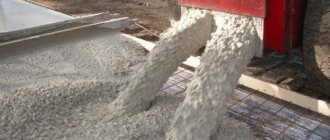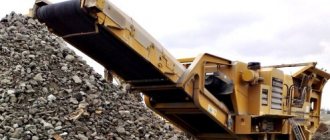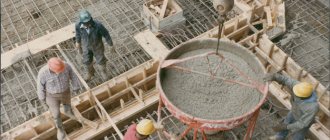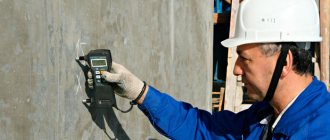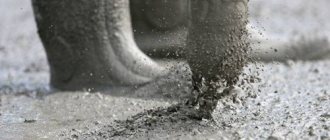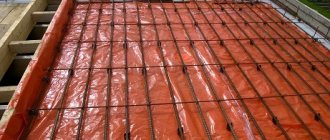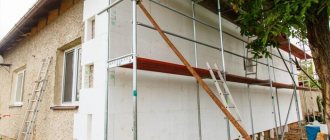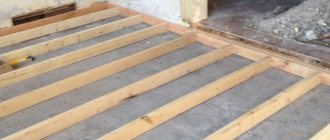Methods to accelerate concrete hardening
Accelerating the hardening of concrete allows you to quickly obtain products with tempering strength, increase the turnover of molds and other equipment, and also use production sites more efficiently.
The main method of accelerating the hardening of concrete is heat treatment. It makes it possible to obtain the strength of products in the required time frame, allowing them to be transported for construction, installed in buildings and structures, as well as to bear existing loads. Therefore, such processing, despite additional costs, increased cement consumption and sometimes a slight decrease in the strength of concrete, is a necessary condition for their factory production. It is especially required for concretes based on lime-sand, as well as low-active mixed and slag binders, since without heat treatment such concretes cannot obtain the required strength in a practically acceptable time.
Heat treatment includes steaming at atmospheric and elevated pressure, electrical heating and radiant heating, holding in a heated air environment, etc. Steaming is the most common. However, the latter is not very effective for products with a thickness of more than 30 cm, made from lightweight concrete of low grades and with a low thermal conductivity coefficient. In these cases, it is often advisable to heat treat the concrete using electricity or natural gas.
During heat treatment, in direct contact of the coolant with the concrete of the product, a steam-air mixture or saturated steam is used, and when heating products in heated molds through thermal compartments, you can use any other coolant that ensures uniform heating of the surfaces of the mold in contact with the concrete.
The intensification of the technology for the production of reinforced concrete products depends mainly on increasing the turnover of molds and forming installations, which is achieved primarily by reducing the duration of heat treatment of products. The latter takes up to 80% with aggregate-flow and conveyor technology and up to 60% with cassette-bench technology of the total mold turnover time. Therefore, any reduction, even a relatively small one, is advisable. The increase in cement consumption sometimes used for this purpose should not take place; The heat treatment time should be reduced using purely technological methods.
The greatest acceleration of concrete hardening is achieved through heat treatment using a set of the following measures: the use of high-grade fast-hardening cements, rigid mixtures with low water/c, rational concrete compositions and heating modes, repeated vibration (with cassette technology), the introduction of hardening accelerators, as well as activation -cement supplied to factories by dry and especially wet grinding.
When steaming and electrically heating concrete, the addition of up to 1% calcium chloride or sodium chloride is very effective (Fig. 1) (a large addition, especially with high-quality and fast-hardening Portland cement, can cause corrosion of the reinforcement). In this case, the concrete must be dense, well-vibrated and with an intact protective layer at least 15 mm thick. It is recommended to introduce an inhibitor - sodium nitrite in an amount of at least 0.6% per 1% CaC12. Chloride additives are especially suitable for concrete based on slag and pozzolanic Portland cement, low-grade Portland cement and at a steaming temperature of 60° and below.
Rice. 1. Graph of the increase in the relative strength of concrete on Portland slag cement grades 300–400 with electrical heating:
I - t = 80° with the addition of 1% NaCl or 1% CaCl2; 2 - t = 80° without additive; t = 60° with the addition of 1% NaCl or 1% CaCl2, 4 - t = 60° without additive
CaC12 has a greater effect on concrete made from rigid mixtures with short heating, and on concrete made from flexible mixtures - with longer heating. With an increase in the specific surface area of cement (above 4000 cm2), the influence of CaC12 decreases. The optimal amount of CaC12 additive in concrete using Portland cement is 0.5-0.6%, and for slag Portland cement it is 1%.
The use of these measures makes it possible to increase the turnover of molds and heat treatment installations to 1.5-2 times, and sometimes more, per day.
Heat treatment of concrete and reinforced concrete products (page 1)
Lecture No. 8 – THERMAL TREATMENT OF CONCRETE
AND REINFORCED CONCRETE PRODUCTS
The following types of heat treatment of concrete and reinforced concrete products are widespread at concrete factories; steaming in batch or continuous chambers at normal atmospheric pressure and temperature 60-100 °C; steaming in autoclaves at a saturated steam temperature of 175-190°C and a pressure of 0.9-1.3 MPa; heating in closed forms with contact heat transfer to concrete from various coolants through the enclosing surfaces of the forms; electric heating of concrete; heating in an electromagnetic field, as well as using solar energy.
Thermal treatment of concrete and reinforced concrete products is one of the most lengthy and critical processes in their production technology. Its essence lies in the fact that when the temperature rises to 80-100 °C, the rate of the hydration reaction of binders increases.
Heat treatment of concrete and reinforced concrete products is carried out until stripping, tempering, and, for prestressed products, transfer strength is achieved.
Stripping strength means the required strength of concrete, upon achieving which it is possible to remove the product from the mold without damage and safely transport it to the storage location.
The tempering strength of concrete according to GOST 13015.0 must be no less than: for products made of heavy concrete of all classes and light concrete of class B7.5 and higher - 70%; for lightweight concrete of class below B%; for autoclaved concrete - 100% of design strength. In the cold season, the tempering strength of concrete is assigned equal to its design strength.
For prestressed products, the transfer strength of concrete is achieved, which is necessary at the moment the pretensioning forces are transferred to it.
Since reinforced concrete products are varied in size, composition, properties, molding methods, requirements for the appearance and quality of the surface, various heat treatment installations are used. These installations differ in their operating principle - periodic and continuous.
Batch plants include pit chambers, autoclaves, cassette plants and cassette molds. Continuous installations include tunnel, slot, vertical chambers, and rolling mill chambers.
Steam and steam-air mixtures, as well as heated and humidified air, are widely used as coolants.
When using electricity as a heat source, the product is heated by direct passage of electric current through concrete or using various heaters and emitters.
The duration of heat treatment is influenced by the mineral composition of cement. When using low-aluminate cements, the duration of heat treatment is usually 13-15 hours. Medium-aluminate cements intensively gain strength in the initial period of steaming, therefore, when using them, the duration of heat and moisture treatment is 10-13 hours. The use of high-aluminate cements is undesirable, since after rapid short-term hardening they sharply slow down the growth of strength both during further heating and during subsequent hardening.
Portland slag cements and rapid-hardening Portland cements (WTC, OBTC) are widely used in the production of precast reinforced concrete. One of the ways to intensify concrete steaming regimes is to introduce hardening accelerator electrolytes into the concrete mixture: calcium nitrite-nitrate (NCN), calcium nitrite-nitrate chloride (HHXK). The use of these additives makes it possible to reduce the duration of isothermal heating by half (from 8 to 4 hours) without reducing strength.
During heat treatment, complex physical processes occur in concrete, causing the appearance of deformations that contribute to the formation of cracks.
When the temperature rises and at the beginning of isothermal heating, the temperature and vapor pressure in the product are lower than the surrounding environment and its outer, more heated layers increase in volume to a greater extent than the inner ones. In addition, the temperature difference in different layers of concrete creates a difference in partial pressures in them. This causes the movement of moisture from the outer layers to the inner ones and the expansion of the steam-air mixture located in the pores, creating excess pressure inside the concrete. During this period, especially with a rapid rise in temperature, significant stresses arise in the concrete and cracks form and the contact between the cement stone and the aggregate is disrupted.
During isothermal heating, hardened concrete increases in volume and, due to the difference in the coefficients of linear thermal expansion of its components, microdefects are formed.
When the temperature in the chamber decreases, the temperature of the concrete and the vapor pressure in it will be higher than in the environment and the movement of heated air in it to the open surface of the product begins, as well as the migration of moisture from the deep layers of concrete with its intensive evaporation.
Thus, in concrete during the period of heat and humidity treatment, residual volumetric deformations are observed that occur in the initial stage of hardening when heating products from concrete that is not yet strong enough, the formation of directed capillary porosity due to the movement of moisture and steam-air mixture, the reduced density of cement stone in concrete caused by insufficient degree of hydration and the formation of larger crystalline hydrates, leading to the appearance of numerous defects causing a decrease in the performance characteristics of products and structures.
So, in the process of heat treatment, along with a number of positive factors that accelerate hardening, there are factors that negatively affect the formation of the concrete structure in the product. The task of technologists is to enhance the influence of positive factors and weaken or eliminate the influence of negative ones. This is done by optimizing heat treatment modes.
Heat treatment
using
low pressure steam.
The heat treatment process consists of four periods: holding products, raising the temperature, holding at maximum temperature and cooling to ambient temperature.
The correctness of pre-curing is determined by the achievement of concrete initial strength, which makes it possible to prevent internal stresses arising during heating without disturbing the emerging structure. The optimal duration of pre-curing varies for different concretes. It depends on the activity of cement, W/C, mobility of concrete and ambient temperature. The higher the grade of cement and concrete, as well as the higher the ambient temperature and the rigidity of the concrete mixture, the shorter the pre-curing time can be.
The introduction of chemical additives (hardening accelerators) leads to a reduction, and surfactant additives lead to an increase in the duration of preliminary aging.
The use of pre-conditioning is especially advisable when steaming stripped products, as well as products with large open surfaces.
When heat treatment is carried out under load, in closed forms, in low-pressure and induction chambers, pre-conditioning is impractical, and when using heated concrete mixtures, it is contraindicated.
The correct setting of the heating mode is of great importance for the quality of concrete during heat treatment. In general, the full cycle of heat and moisture treatment of concrete and reinforced concrete products consists of the following periods (Fig. 8.1.a ):
preliminary holding τpred;
heating the product τI, isothermal holding τII ;
cooling τIII.
Preliminary exposure at normal ambient temperature is recommended for concrete from mobile and low-flow mixtures for 3-6 hours, from rigid mixtures for at least 3 hours, and from particularly hard mixtures for at least 2 hours.
The temperature in the steaming chamber should be raised gradually to avoid significant temperature changes in the product.
The permissible maximum rate of temperature rise (with free moisture and heat exchange and the presence of open surfaces of the product) for non-massive products is 30-35 ° C / h. The more massive the product, and the greater the initial water content of the concrete mixture, the slower the temperature rise should be. The rate of temperature rise for large-sized thin-walled products (ribbed and hollow-core floor slabs, truss elements, etc.) should not exceed, and for more massive products, 20 °C/h. Increasing the temperature of the chamber environment at a rate of more than 60 °C/h, regardless of the initial strength of the concrete, is not recommended.
Get full text
Rice. 8.1 – Graphs of heat treatment modes for concrete:
A -
heat treatment mode options;
b
- warming up of products of various thicknesses; c - stepwise heat treatment mode
With a short preliminary holding (up to 1 hour), it is recommended to raise the temperature at an ever-increasing speed, for example, in the first hour - 10-15 °C, in the second - 15-20 °C, in the next 25-35 °C, etc. regardless of the thickness of the product.
If it is technically difficult to carry out modes with a constantly increasing rate of rise in the temperature of the chamber environment, it is recommended to use modes with a stepwise increase in temperature, for example, raising the temperature to 30-40 ° C in 1-1.5 hours, maintaining at this temperature for 1-2 hours. , and then an intensive rise in temperature to the maximum accepted for 1-1.5 hours. If the product is loaded into a steaming chamber with a temperature of 30-35 ° C, then keeping it in it without steam for 1.5-2 hours is equivalent to the first stage of rise temperature.
The optimal isothermal heating temperature when using Portland cement is 80-85 °C. When using slag Portland cement, the heating temperature can be taken equal to 90-95°C.
The duration of isothermal curing during steaming is prescribed depending on the required strength of concrete products (stripping, transferring, tempering) immediately after curing the concrete or taking into account the increase in strength during subsequent hardening at positive temperatures in a workshop or warehouse for up to 1 day.
Optimum temperature for isothermal curing of products based on low- and medium-aluminate Portland cement (with a C3A content of less than 8%) —
80°С, on high-aluminate Portland cement – 60 0С, on slag Portland cement – more than 90°С.
Find out the cost of your work
Free order evaluation!
Acceleration of the hardening process is carried out by using high-grade fast-hardening cements, mechanochemical activation of binders, using rigid concrete mixtures and additives - hardening accelerators.
The cooling rate of products in the chamber after turning off the steam supply should not exceed 30-40 °C/h, depending on the massiveness of the product. In order to reduce the destruction of concrete, with the requirement for frost resistance, the rate of temperature decrease should be no more than 15-20 °C/h.
According to GOST, cements are divided into three groups according to their efficiency during steaming (Table 8.1).
Table 8.1 – Types and groups of cements
Table 8.2, for lungs - in table. 8.3.
Table 8.1 – Heat treatment modes for products made of heavy concrete at an isothermal holding temperature of 80-85 °C
| Class (strength) of concrete | Heat treatment mode, h at product thickness, mm | ||
| Up to 160 | Up to 300 | More than 300 | |
| B 15(20) | 11(3,5+5,5+2) | 12(3,5+6,5+2) | 13(3,5+6,5+3) |
| B22.5(30) | 9(3+4+2) | 10(3+5+2) | 11(3,5+5+2,5) |
| B30(40) | 8,5(3+3,5+2) | 8,5(3+3,5+2) | 10(3+4,5+2,5) |
| B37.5(50) | 7(3+3+1) | 9(314+2) | 10(3+4,5+2,5) |
| B45(60) | 7(3+2+2) | 8(3+3+2) | 9(3+3,5+2,5) |
Table 8.3 – Heat treatment modes for products made from lightweight concrete (tempering strength of concrete 70-80% of design)
Prestressed structures manufactured on benches are recommended to be subjected to heat treatment according to the following regime:
— temperature rise to 80 0C……………….. 7
— isothermal holding at 80 0С 6.5
- cooling. ,…………………………………………………… 1.5
At reinforced concrete factories, heat treatment of concrete and reinforced concrete products in pit steaming chambers, in horizontal and vertical continuous chambers is widely used.
Pit chambers of periodic action - completely or partially buried in the ground or floor-mounted. The main elements are walls, a floor with a sewer for drainage, covers with a hydraulic shutter and a steam pipeline system with shut-off and control valves for supplying steam to the chamber.
The chambers operate according to a specific cycle, during which the products first undergo all three stages of heat treatment - heating, isothermal heating and cooling.
Steam enters the chamber through a looped perforated pipe located near the floor of the chamber along its perimeter. The rising steam mixes with air and forms a steam-air mixture. With such a distribution of steam, it is difficult to create a uniform temperature distribution throughout the entire volume. A temperature difference in height will be created (up to 30-40°C). The highest temperature is at the top, and the lowest is at the bottom. Products located in the lower part of the chamber find themselves in less favorable conditions.
A more advanced type of pit chamber is shown in Fig. 8.2, characterized in that it has a so-called shaped pipe at the bottom for removing the steam-air mixture or excess saturated steam, and also in that in addition to the lower steam distribution, it has an upper distribution. This allows steaming to be carried out not only in a steam-air environment, but also in an environment of saturated steam without air admixture. For this purpose, at the initial stage of heat treatment, steam is supplied through the lower wiring. When the temperature reaches 80-90 °C, the lower wiring is turned off and steam is supplied through the upper wiring. Gradually, the chamber is filled only with steam, which makes it possible to reach a temperature in the chamber close to 100 °C. Favorable hardening conditions are created throughout the entire volume of the chamber.
| Rice. 8.2 – Steaming chamber of the system: 1 — steam line; |
Continuous thermal installations are multi-tiered tunnel, slot and vertical chambers.
Continuous tunnel chambers are horizontal tunnels in which trolleys with products move along a rail track. Trolleys with products are loaded and unloaded using portal lifts and lowerers. Tunnel chambers are usually multi-tiered (from 1 to 6 tiers). The coolant can be steam, as well as a steam-air mixture heated in air heaters. The chambers have three zones: temperature rise, isothermal heating and cooling. The zones are separated from one another by thermal air curtains. The disadvantage of these chambers is the large heat loss through the ends.
Slit chambers have a slightly different shape, their height is 4-6 times less than their width. They are equipped with steam supply systems and electric heaters. The efficiency of these chambers is due to lower heat losses (Fig. 8.3).
Rice. 8.3 – Horizontal slot chamber: 1 – trolley with a product in the mold; 2 - reducer; 3 — mechanical curtain; 4 — rails; 5 — sealing curtain; 6 – lift
In vertical chambers (Fig. 8.4), products in trolley molds are first moved upward through various heat treatment zones by special lifts, then lowered down and unloaded from the chamber. Vertical chambers use natural stratification of steam and air in height. In the upper part, where the steam is located, the temperature is maintained at about 100 °C. The lower part of the chamber is filled with a steam-air environment, the temperature of which drops to 30-35 0C when the products are lowered. Vertical chambers, compared to multi-tier tunnel chambers, have a 5-6 times smaller volume and lower steam consumption (100-120 kg/m3).
Rice. 8.4 – Vertical chamber for heat treatment of concrete: 1 – construction box; 2 —
lifting mechanism frame;
3
- guides;
4
— folding brackets;
5 — conveyor drive; 6 —
upper transfer trolley;
7 —
drive of movement of the transfer trolley
Contact heating.
The essence of heat treatment by contact heating is that the product, heating up as a result of direct contact with the hot environment, is at the same time separated from it tightly - and by moisture-proof partitions, eliminating the possibility of exchange between the environment and the concrete product.
Two methods of contact heating are used. In the first case, the coolant (hot steam, superheated water under pressure, oil, hot gases) circulates in a closed space, which is adjacent to the product on one or both sides. For example, in cassette forms, packaging machines (Fig. 8.5, 8.6).
The second method is that the product, closed on all sides, is placed in an environment in which the coolant circulates, for example, heat treatment in a vibrating rolling mill.
Rice. 8.5 – Diagram of the cassette form: 1 – coarse for supplying steam; 2
- perforated pipe;
3
— transverse side;
4
- pipe for condensate drainage;
5 — emphasis; 6
- pallet;
7
- lock;
8
— longitudinal side;
9
— dividing partition;
10 —
eye for removing the side from the pallet; 11 — eye of the hinged device for fastening the side
Cassette installations (Fig. 8.5) are a block of vertical forms separated by thermal compartments. In the upper and lower parts of the thermal compartments there is a distribution of perforated pipes, through which live steam or other coolant is evenly distributed over the entire area of the molded products. Due to the small open surface area of concrete in cassettes, a high rate of temperature rise is allowed (60-70 °C/h). Products can be heated without preliminary exposure. However, the products are characterized by uneven strength in different places along the height. This is caused by different intensities of heating. Areas close to the steam injection point heat up faster.
Rice. 8.6 – Baler design: 1 – guide post; 2
- hydraulic jack,
3 -
traverse,
4
- stand,
5
- cut-off stop
Recommended modes of heat treatment of products in cassette installations are presented in table. 8.4.
Table 8.4
Heat treatment mode for products made of heavy concrete » cassettes (with steam compartments located across two working compartments), in bags
| Thickness of concrete in products, mm | Class (strength) concrete | Heat treatment mode at 80-90 °C, h |
| Up to 100 | B12.5(15) | 1+4+4=9 |
| 101-200 | B12.5(15) | 1+5+5=11 |
| Up to 100 | B 15(20) | 1+3,5+3,5=8 |
| 101-200 | B 15(20) | 1+4+4,5=9,5 |
| Up to 100 | B25(35) | 1+3+3=7 |
| 101-200 | B25(35) | 1+3,5+4,5=9 |
Another representative of installations for contact heating of products are horizontal thermoforms. Unlike vertical thermoforms, heat treatment in horizontal molds achieves greater uniformity of heating of products. Packages are assembled from horizontal moving thermoforms using a special device - a bagger (Fig. 8.6).
| Due to its large volume, this material is placed on several pages: 1 |
Hardening of concrete in natural conditions
Concrete is used in almost any construction because it is a universal material. An additional advantage over other options is the reasonable cost, which is very beneficial. There are several ways to use concrete in construction work. The simplest option is to make masonry from ready-made blocks and slabs. This method has its strengths and also disadvantages. It cannot be used in all cases, which implies the need to lay the composition in special forms - formwork. Their preparation takes place in advance and requires compliance with several important rules. After the composition has been placed in the formwork, the process of hardening begins, which is most often carried out under natural conditions. This process should be considered in more detail in order to have the necessary understanding of it. During the natural hardening of concrete, first of all, it sets. This process begins after several hours from the moment of installation and involves the formation of primary bonds. A chemical reaction begins between water and cement in the concrete, which leads to its gradual hardening. The ultimate goal is to bond all the elements together with a frozen binder. Depending on the temperature, setting lasts from several hours to a day. During its implementation, it is not recommended to apply any types of loads, as this will negatively affect the quality of the structure.
As concrete hardens naturally, its strength characteristics increase. They are measured in terms of the pressure that must be exerted per unit area to cause irreversible destruction. The process of gaining strength does not occur in a uniform mode, but with a slowdown. So, after a few days the composition has 30 percent of the required value. By the end of the first week, the strength is 70% of the required level. The standard time during which concrete hardens naturally to the required level is a calendar month. Only after this period can the load be placed on the structure without the danger of its destruction. It is worth separately noting the fact that hardening can be accelerated by various methods. Curing concrete under natural conditions is the most popular option for carrying out such activities used today. This allows you to achieve some advantages and, above all, it should be noted that such activities are easy to implement. There is no need to use special equipment or solve other similar problems. Curing of concrete under natural conditions occurs without the need for human intervention, except in cases where environmental conditions are considered suboptimal and it is necessary to ensure their compliance with the standard. This provides money savings, as well as some other benefits.
Hardening of concrete under natural conditions has a given time interval. It is 28 days, which is a very long period. Such a long time means that during the work you can encounter numerous problems. If a foundation or any other structure is being poured, problems arise. It is necessary to stop work for the entire period of converting the composition into a monolithic mass. This causes some cash costs, which is not a positive factor. Natural hardening of concrete is considered the least energy-intensive, which allows us to talk about its convenience in a number of cases. The process can be slowed down when exposed to external factors. For example, the temperature of the surrounding air and soil plays a significant role. When this indicator decreases, chemical reactions begin to proceed much more slowly. At negative temperatures, the natural hardening of concrete almost completely stops. The process can no longer continue and the molecular bonds stop, which is a serious problem. It should be said that this starts from those places where there is the largest area of contact with the cooled environment. The natural hardening of concrete slows down, especially in the corners of the formwork and the edges of the blocks.
It should be said about the great importance of the regime that will be present in the process of gaining strength. At the same time, you should take into account not only temperature indicators, but also humidity. Failure to take this factor into account will lead to some problems associated with a decrease in operational parameters. It should be noted that minor deviations in low-rise construction do occur, since there is a significant margin of safety. If the natural hardening of concrete occurs on alumina type of cement, then there is a release of heat during chemical reactions. This factor does not have a positive effect and leads to significant problems, including a decrease in strength characteristics. Thus, if this type of composition is used, you should think about ensuring its cooling.
Regardless of the method used to gain the required strength, in any case it will be necessary to carry out additional measures. For example, this includes regular watering. In most cases, installation is done in the summer and water evaporates through the surface. Depending on the temperature and intensity of solar radiation, watering is carried out from one to six or more times a day. As a rule, it is necessary to perform such procedures from three days to one week. Then the natural hardening of concrete will ensure the maximum quality of the result.
